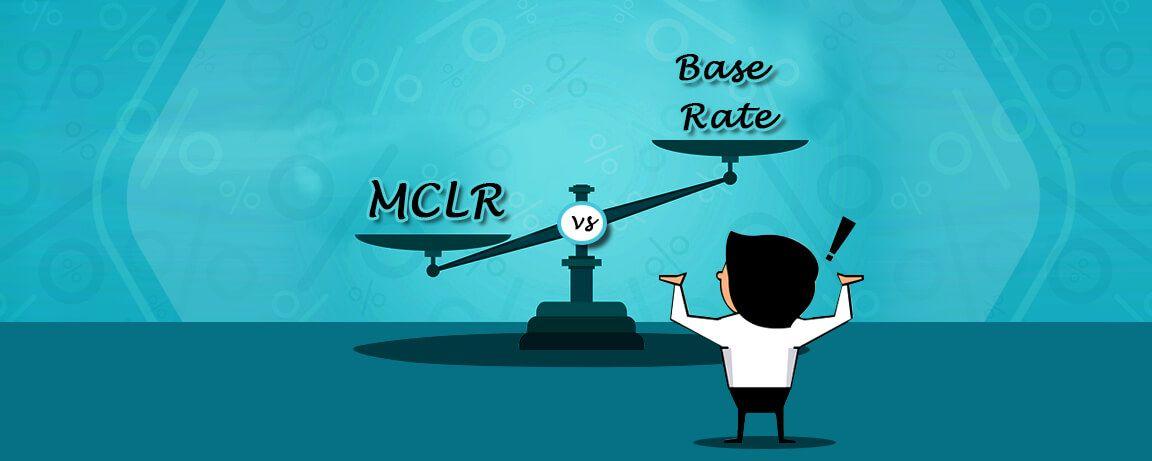MCLR vs. Base Rate: Difference Between MCLR and Base Rate
It was back in July 2010, the Reserve Bank of India (RBI) introduced the base rate system. This system was announced to make sure that there was a minimum lending interest rate threshold for commercial banks as well as NBFCs in India.
After about 5 years of bringing in the Base Rate System, it was observed that there were a few loopholes which essentially defeated the main purpose of enabling the transmission of the change in the rate of interest to the customers. To rectify the same, and to introduce a more efficient measure, the RBI brought in MCLR, or Marginal Cost of Funds based Lending Rate, in the year 2016.
While shifting your Home Loan from Base Rate System to MCLR may help you save on the interest outgo, you should only make this switch, if the cost of switching is lower than the amount you will end up saving. If not, it is better you continue servicing your Base Rate Home Loan.
To better understand the concepts, let’s take a quick rundown on MCLR and Base rate below:
Additional Info: Looking for Plot Loan
Marginal Cost of Fund Based Lending Rate (MCLR)
MCLR is essentially the lowest rate at which a bank or NBFC can offer a loan. It is directly linked to actual deposit rates, and hence varies from one lender to another, and also from one-time span to another. Unless specifically allowed by the RBI, no bank or NBFC is permitted to offer loans at interest rates lower than the MCLR.
Ever since its introduction in the year 2016, MCLR has been governing the interest rates for all loans offered in India.
Two of the most prominent benefits of MCLR are as under:
- It guarantees that the lending rates of banks and NBFC sreflect the policy rates
- It brings about enhanced transparency in the process that banks follow for the determination of interest rates on loans
Additional Info: Also Check Tax Benefit on Second Home Loan
Factors that Determine the MCLR
MCLR essentially takes into consideration the incremental cost of funds, for the determination of interest rates.
The factors affecting the MCLR include –
- Marginal Cost of Funds – This holds the maximum impact on the determination of MCLR Rate, with a 92% stake. Marginal Cost of Funds refers to the cost incurred by the lender to offer an additional loan when the cost of funds remains unchanged.
- Operating Costs – As the name suggests, these are the expenses incurred by the bank to run the day-to-day operations, raise funds, and offer loans.
- Cash Reserve Ratio (CRR)– It is the minimum percentage of the overall customer deposits that the lender should have deposited with the RBI at all times.
- Tenor Premium – It is the premium charged for long-term loans with the aim of diminishing the associated risks.
MCLR mandates every lending institution to submit a total of 5 distinct rates to the RBI, for One Year MCLR, Six-Month MCLR, Three-Month MCLR, One-Month MCLR, and Overnight MCLR.
Base Rate
Base Rate can be defined as the minimum interest rate below which a lender is not permitted to offer loans. Introduced in the year 2011, the Base Rate System was implemented with the following objectives –
Additional Info: Looking for 1 Crore Home Loan? Check EMI & Apply
- To improve the transmission of monetary policy
- To introduce a higher level of transparency in the approach of a selection of lending rates by banks.
Yes, when it comes to the objectives, MCLR and Base Rate seem identical, however, the underlying difference between the two lies in the fact that the MCLR is determined based on the current cost of funds, while the Base Rate is determined on the basis of the average cost of funds.
Additional Info: Also Check Monetary Policy
Factors That Determine Base Rate
Base Rate, fundamentally, takes into consideration the average cost of funds, for the determination of interest rates.
The factors affecting the Base Rate include:
- Average Cost of Funds – This is nothing, but the interest rate that the bank offers on deposits.
- Operating Costs – As the name suggests, these are the expenses incurred by the bank to run the day-to-day operations, raise funds, and offer loans.
- Cash Reserve Ratio (CRR)– It is the minimum percentage of the overall customer deposits that the lender should have deposited with the RBI at all times.
- Margin of Profit – Also known as the Average Return on Net Worth, it denotes the profitability of the bank.
As is the case with MCLR, even Base Rates vary from one bank to another, majorly due to the difference in the average cost of funds.
Differences between MCLR and Base Rate
Here are two aspects that are the major differentiators for MCLR and Base Rate –
Calculation - While the calculation of MCLR is primarily based on the marginal or incremental cost of funds, Base Rate is calculated on the basis of the average cost of funds.
Dependence - MCLR depends on the tenor premium earned by the lender, while Base Rate is contingent on the profit margin of the bank.
The MCL Rensures that the rates of interest are more receptive to the changes in the policy rates, thereby assisting in effective implementation of the monetary policy in the country.
Also read: SBI Cuts MCLR Again: Home Loan Gets Cheaper Across All Tenures
To apply online for Credit Cards, Secured Loans and Unsecured Loans, visit www.mymoneymantra.com, the leading online lending marketplace that offers financial products from 100+ Banks and NBFCs. We have served 5 million+ happy customers since 1989.
